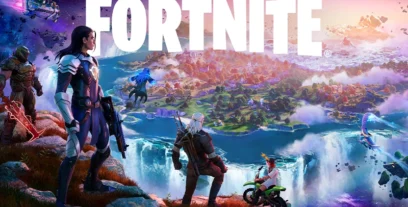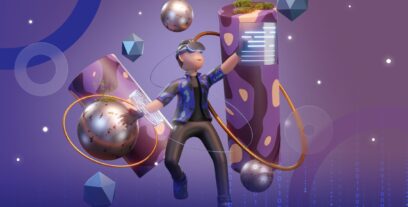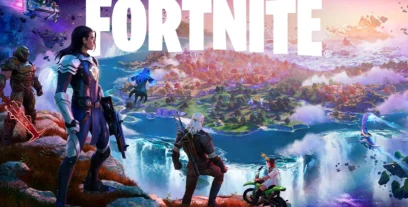
Neal Stephenson coined the term “metaverse” for the first time in his novel Snow Crash in 1992. Now, as the metaverse emerges from the realm of science fiction into reality, the author is back with Lamina1 Blockchain, a new company that aims to provide a framework for an “open metaverse”—in other words, something more aligned with it. The core vision of Web 3 prioritizes independent creators over corporations.
What is the metaverse?
Many marketers have probably never heard of Stephenson, but almost everyone by now has heard of the Metaverse—the loosely defined cyberspace commonly described as, and built upon, the next evolutionary stage of the Internet.
The Metaverse is a virtual urban environment that can be accessed by a global fiber optic network and virtual reality headsets, as depicted in Stephenson’s Snow Crash novel celebrating its 30th anniversary this year.
Blockchain technology completely frees it (at least in theory) from the top-down control that dominates the flow of information in the Web 2 era.
What is the concept of Lamina1 (blockchain)?
As the name suggests, Lamina1 is designed as a Layer 1 blockchain, meaning it can create its own rules and validate its own transactions. (Bitcoin and Ethereum are both layer 1 chains.)
As Stephenson explains, “The advantage of starting your own [blockchain] is that you can make engineering decisions that fit your goals, rather than just sticking together. And be subject to the existing rules. You can make your own rules or ride with someone else’s system.”
What is layer 1 in blockchain?
Network layer 1 is the basic foundation of a blockchain platform. It executes all on-chain transactions and thus acts as the public ledger’s source of truth.
Processing a transaction, for most networks, involves registering a user’s crypto wallet through asymmetric key pairs and its corresponding coin or token balance. This transaction is done through a consensus mechanism – which is distinct for each platform – to confirm and finalize the trade or sale. In addition, layer 1 blockchains host their own native token, which is used to cover transaction costs or gas costs.
Determining the right consensus mechanism for a platform comes down to a trade-off between three main features: security, scalability, and decentralization. This compromise is commonly referred to as the “Blockchain Triad,” a concept originally identified by Ethereum founder Vitalik Buterin. Anything not fully covered by Layer 1 protocols—typically scalability—can be compensated for in a Layer 2 protocol built on top of it (more on that later), which acts as an extender. It works for the main network function.
When does the history of the formation of Lamina 1 go back?
Stephenson co-founded Lamina1 earlier this year alongside Peter Wesens, an early and influential crypto pioneer who serves as the company’s chief executive officer and chief crypto officer. Former Bitcoin Foundation chairman Vessenes will be CEO of Lamian1, while Stephenson will serve as president of the platform.
Peter Vessens (left) and Neil Stephenson are the founders of Lamina1.
What is the purpose of forming Lamina1 for its creators?
Both plan to launch a new immersive environment based on Snow Crash, as well as build infrastructure and tools to help third-party developers build Open Metaverse experiences at scale.
Vance describes Lamina1 as “a place to build something closer to Neal’s vision – a place that rewards creators, technically and artistically, a place that supports, spatial computing technology and a community to support those who are building the Metaverse.” are. It also wants to help workers get paid fairly for their work, help the environment, and see the emergence of a truly open metaverse rather than the monopolies’ vision of a metaverse.
Vessenes hopes to contribute to the economic and technological design in Nile’s vision that will allow Lamina1 to be developed sustainably, and to deploy Lamina1 as quickly as the processes that come together to make it happen.
Stephenson also shared a few tidbits about the Metaverse via Twitter. He believes that current game development is still focused on displays for both the developer and the user, and that Metaverse uses a hybrid approach that includes 2D displays and AR/VR technology, not just VR.
The main goal is actually to correct the disadvantages of the past.
Although Web2 ushered in an era of rapid innovation and unprecedented access to entertainment, information, and goods on a global scale. Simple tools and usability brought creators and innovators to the web in droves to build digital storefronts, interact with and transact with their customers.
Owning and controlling that growing ecosystem of content and personal data has become an early and profitable initiative for large corporations. According to the creators of Lamina1, consumer behavior, recorded on the company’s centralized servers, provides consistent and privileged insight into how to monetize human emotion and attention. At the same time, we’ve seen a strong movement among creators and consumers around data privacy, transactions, and asset ownership. The near-constant news of data abuse is driving new consumer awareness of the open data and privacy practices of major platforms. Those who use these services are increasingly aware (and wary) of how their virtual identities are stored, tracked and commodified online – with 74% of internet users saying that more than any Another time they worry about their online privacy.
The disadvantages were:
Digital disruption, followed by corporate opportunism, reset the value of creative IP and negatively impacted the creative process. Agencies and intermediaries took their revenue away from creators. Data was collected, sold, commodified and exploited.
How does Web3 perform compared to Web2? Is there an advantage?
At its best, Web3 envisions a better world by thoughtfully redesigning our online lives, creating stronger protections for our interests, freedoms and rights, according to the company. As Web2 flourished with the maturation of tools and services that offered ease of use to creators and consumers, the open metaverse leverages open protocols for payments and data and a set of mutually decentralized services to support virtual worlds. Lamina1 will be the gathering point for an ecosystem of open source tools, open standards, and enabling technologies designed and developed with a vibrant community of creators.
Web3 trend review
The past two years have seen unprecedented growth in Web3, with manufacturers turning to NFT to provide direct access to their markets. In 2021, collectors sent more than $41 billion to online markets and more than $37 billion in the first half of 2022. Ethereum’s ability to provide developers with (albeit limited) Web3 features, along with security and anonymity for consumers, has expanded the market nearly 200x between 2020 and 2021. And in 2021, NFT sales increased from $100 million to $18 billion. Last year, OpenSea’s direct market handled nearly 60% of these transactions.
To fully understand the needs and complexities of an expanding metaverse, the next era of digital ownership must include a deeper integration of persistent digital objects, virtual real estate, and interactive services that expand on the basics and address their needs. As this new digital economy crystallizes, so does the potential to overhaul financial systems and the underlying structures that fuel it, say the creators of Lamina1.
What will the future of Lamina1 look like?
Unlike Snow Crash – and the various visions of the metaverse being propagated by companies like Meta – Lamina1 does not offer any long-term predictions for the future of the metaverse. Instead, it aims to provide the basic tools that technical and creative developers need to implement their various projects. The real world is people using them, Stephenson says. The best thing that can be done at this point is to help with the infrastructure and provide tools that are useful to people who want to build the Metaverse.
“The street finds its own uses for things,” he says, quoting author William Gibson, who is often credited with inventing the cyberpunk subgenre. (It’s worth noting that “Street” is Stephenson’s name for the main thoroughfare of the Metaverse in Snow Crash.)
However, given the promise of huge potential profits, many companies have tried to find uses for the street, creating hype about the metaverse as if it had already arrived. “When someone says, ‘We’re building a Metaverse,’ or ‘our Metaverse,’ you can tell they don’t quite understand the concept,” Stephenson says. “There is only one metaverse.
Reports point to the advancement of gaming towards a metaverse with hundreds of millions of online games. Worldwide, spending on virtual goods will reach $110 billion in 2021, with nearly 30% attributable to virtual equipment. It can also be predicted that the value of this metaverse will reach 5 trillion dollars by 2030.
What is the plan of the creators of Lamina1 for its future?
Although this project is still in the planning phase, in general, until this technology is fully launched, the roadmap of this company from the beginning of work to planning for the future can also be mentioned:
Year 2022
- V1 Lightpaper September 2022 release
- Engine/Web SDK and Wallet Alpha Oct
- Test net November 2022
- MVPAlpha browser December 2022
- EVM + December 2022
- Early Studio Beta December 2022
Year 2023
- Engine/Web SDK and Wallet Beta January 2023
- Blockchain reconstruction in January 2023
- The pre-production of the original game will begin in the first quarter of 2023
- Betanet Q1 2023Mass
- MVPalfa Q1
- The studio will be launched in Q2/3 2023
- Mainnet Q2/3 2023
The LAMINA1 test network and betanet are scheduled to be released later this year. To make this happen, the company is currently looking for engineers, technologists, business development people and space industry veterans.
What are the benefits of Lamina1?
Lamina1 uses a high-speed Proof-of-Stake (PoS) consensus algorithm, which is customized to support the needs of content creators – creating a source for the creator and allowing the documental and behavioral characteristics of an object to multiply, customize and Compose on it.
Starting with Avalanche, a robust distributed blockchain that offers the industry’s most scalable and efficient blockchain for managing digital assets to date. This starting point supports Lamina1 with a flexible architecture and an extensible platform to support our goals in data storage, interoperability, integration incentives, carbon negative operations, messaging, privacy, high-scale payments and identity.
Who will you be in the metaverse?
With Open ID Connect, all users will have the opportunity to differentiate themselves with the following four identity categories:
- Personal identity: the individual as a human being.
- Independent identity: diving license or passport ID, provided by the nation/country
- Autonomous identity: A Twitter or social media identity provided by a centralized entity
- Permissionless Identity: Decentralized identity like an Ethereum address
Authentication in Metaverse
The team plans to use the zkSNARK technology to prove these identities in the future, as research continues. The last three are on the short-term goal timeline, while personal identity will be a long-term goal.
The Lamina1 blockchain will also improve the quality of life of EVMs. Basically, more technical improvements are made to the Ethereum Virtual Machine to further strengthen the Open Metaverse. These improvements include cross-chain support for proof-of-work and ETH2 validation in Solidity smart contracts and Self-Hosted Gas Inside to aid in the onboarding process.
Most of us have heard of SaaS, Software as a Service, but have you heard of Metaverse as a Service (MaaS)?
Lamina1 encourages the creation of a set of interactive decentralized services to support virtual worlds. MaaS and ecosystem technologies ideally enhance or integrate existing open source solutions or are provided directly by third parties. In short, the team will take existing technology and configure it for Metaverse applications and use cases.
One of the focal points of MaaS will be the storage layer, as there will be a need for exabytes of fast data delivered with *reasonable* safety, proven availability and relatively low latency. Turns out, Lamina1 prioritizes latency and bandwidth concerns over “perfect” safety.
In order to enhance interoperability and composition, Lamina1 will work with technology providers to provide decentralized services tailored to each global country and manage state changes that are coordinated between all participants. Whether it’s a small number of participants using less bandwidth, or a higher number of participants with more complex gameplay that requires less latency, the Lamina1 will hold up.
Lamina1 will approach the open Metaverse with a multi-pronged approach including Layer 1 blockchain, Metaverse-as-a-Service (MaaS), community economic participation and incentives, and original content. We will discuss each of these deliverables further below:
As a blockchain overview, Lamina1 uses a high-speed Proof-of-Stake (PoS) consensus algorithm, customized to support the needs of content creators – creating a source of creativity and enabling the creation of customized behavioral and documental features of an object. and formed on the chain. The team previously mentioned that they will use blockchain as a starting point, which gives Lamina1 the most flexible architecture to develop.
What should you expect in the Lamina1 blockchain and how will it differ from existing blockchains?
First and foremost, the team wants to provide the community with all the Open Metaverse data you’ll ever need. Metaverse metadata should be easy for developers to access from the storage layer, opening up the ability to composit digital objects in the same way that ERC-20 enables composable exchangeable tokens, which is exactly what will happen. .
One of Lamina1’s core values is environmental sustainability, which is why Staking Token Carbon is essential to have a negative carbon footprint. For each node operator, the team assesses energy requirements and verifies that each step in the PoS validation process involves retiring the appropriate number of carbon credits tokenized on Lamina1.
One of the most important factors in building an open metaverse is “openness” or interoperability. Lamina1 provides cross-chain integration and is easily decoupled in a Mainnet setup to support cross-chain data and value transfers from existing Layer 1 blockchains.
By empowering creators to earn and receive the economic recognition they deserve, Metaverse needs a high-performance system to pay each other. Lamina1 has prioritized high-scale payments and is currently in the early stages of building a high-performance, high-scale payment sub-network. It allows users to easily create a pay group of hundreds of thousands of payees, pay them securely, and allow these payees to receive their payments cheaply.
According to reports, the Lamina1 carbon negative chain will have a large transaction volume and an economic architecture with new reward mechanisms to help innovators and entrepreneurs create ideal economies.
Lamina1 will serve as the base layer for Open Metaverse.
Who are the investors of LAMINA1?
Although specific details about LAMINA1 are not yet publicly available, there are some reports of potential investors. Joseph Lubin, one of the founders of Ethereum, is one of the notable names among the list of investors of this project.
Peter Wesens talked about his goals and how he wants to focus on getting the blockchain off the ground as he tries to get the necessary governance, node operators, technology, artists, IP partners, business partners and capital in place.
How many employees does Lamina1 currently have? On August 25, 2022, the company announced that it had hired creative strategist and product expert Rebecca Barkin as president. Barkin and Stephenson had met during their tenures at Magic Leap, an augmented reality (AR) company that released its first headset in 2018. In an interview, he explained more about how he works, as well as more explanations about Lamina1 and its function. According to Barkin’s explanation, which he first mentions, he was brought in partly “to sort out the chaos and destroy everything. ” he adds, describing Lamina1 as “built to run experiments in metaversion, focusing on things we know are important, [like] data storage. Interoperability on the chain, identity, commerce and of course quality and usability. “By emphasizing these elements, we can really help grow a real community.”
It has always been about providing the best SDKs and environments for developers to build on Metaverse.
Ms. Barkin also emphasizes the need for the Web 3 community to reflect on the past and learn from it to build a better future: “Here we have the opportunity to undo some of the decisions we’ve all made. Because of the convenience or lack of knowledge at the dawn of the Web2 era, and to give a lot of that power back to creators and consumers… there’s a cultural movement toward agency and ownership… we want to be a part of that,” he says. We want to be leaders and say, “Look, you have a lot to offer the world, and we want to be where you come to do it.”
All things considered, Lamina1 currently employs only 3 engineers, despite plans to hire 20-200 more to develop its blockchain and all-around technologies.
Predicting the success rate of Lamina1 in the future
In a purely economic sense, it’s hard to see how Lamina1, and not many other metaverse-centric projects, could reach, let alone displace, multi-billion dollar projects like Meta.
If, supposedly, such a feat is to be achieved, the inevitable dilemmas surrounding pre-existing metaverse platforms such as The Sandbox, Decentraland and the Otherside will arise, ie will they go all out to build on Lamina1’s “rails”? Or will they eventually disappear by ignoring it?
With that in mind, if the project was to be as successful as it wanted to be, the overall capability of the product and its team would have to be “pristine enough” to beat the frontrunners in the “Metaverse race,” or rather Alternately, it has been developed and marketed in a way that leaves the pioneers with no choice but to transfer or start building on platform rails. In any case, and despite the huge obstacles in their way, we can only Stephenson And kudos to the Lamina1 team for their ambition.
Furthermore, and for those who fully understand the concept of the metaverse (despite its current ambiguities), it is intuitive to see how a “Lamina1-like” metaphysical reality is fundamentally inevitable, which is why it is poetically , it will be so. It is incredible to see such a fact that it is the brainchild of the man who first coined the term.
final word
We’ll have to wait to get more updates on this super futuristic project and see what approach the founders will take on this. When Neal Stephenson first introduced the Metaverse thirty years ago, he didn’t expect the technology to go this far. Father Metaverse is ready to take things to the next level! What this basically means is that over time (an unspecified amount), Metaverse enthusiasts will no longer have to choose which platform they want to live their virtual lives on, as Lamina1 will act as a monopoly in hosting all future Metaverse ventures.








Comments (0)